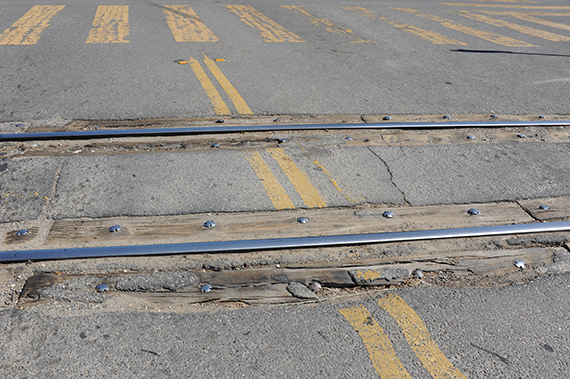
|
Pedestrian access points on the Bike Trail will be getting some attention but a majority of vehicle jarring railroad crossings will have to wait for new funding. Above is thbe Railroad Crossing at Steckel and Main Streets. |
Council approves fixes for Bike
Trail pedestrian, three RR crossings
May 06, 2015
By Peggy Kelly
Santa Paula News
Pedestrian access points on the Bike Trail will be getting some attention but a majority of vehicle jarring railroad crossings will have to wait for new funding.
At the April 20 meeting the City Council directed staff to apply for $1.1 million in federal funds to fix several railroad and pedestrian crossings. Interim Public Works Director Brian Yanez told the council that the issue has been one rife with challenges from almost losing $4+ million in funding to create the bike path to a misunderstanding with the Ventura County Traffic Commission on what constituted street crossings versus railway crossings, the latter now badly in need of repair.
The city maintains that VCTC must maintain the rail crossings but three are in desperate need of repair as evidenced by public complaints and claims of vehicle damage.
In all, there are nine railroad crossings that cross city streets and 16 pedestrian crosses along the Bike Trail that need attention.
Yanez suggested that funds in city coffers could be used to fix the worst railroad crossings — those at Cameron Street, Steckel Drive and Dean Drive — first.
“I have been hesitate, the city manager has been hesitate to repair street crossings that are not the responsibility of the city,” but Yanez noted, “You get complaints, we get complaints, I can’t tell you the number of claims we’ve received in administration,” for vehicle damage from driving over degraded railroad crossings.
The city has funding to fix pedestrian crossings as well as create a Bike Trail shade structure that was dropped from original plans due to costs, but Yanez told the council part of the account could also repair the three worst railroad crossings.
A federal Congestion Mitigation and Air Quality Improvement (CMAQ) grant could bring $1.1 million for railroad crossing repair but Yanez noted the process for obtaining such grants requires much staff time with uncertain results.
Yanez asked the council for direction and noted, “Those crossings are very important to citizens…”
Although recognizing the “enormous needs on our streets” Councilwoman Ginger Gherardi said, “I do not agree to using gas tax money to fix those crossings,” and she questioned other funding sources.
She also noted the city did not apply for additional VCTC administered bicycle trail funding, “$135,000 left on the table,” and the city can be more proactive in grant applications and apply shortcuts to the bid process.
But overall, “I agree with prioritizing projects and doing the worst of them,” while looking for financial solutions for the others.
But Gherardi noted she wants the city to “maximize local dollars” on local streets and a “pavement management system” must be crafted to address the outbreak of potholes.
Yanez said VCTC has given the city a verbal commitment to help with the grant process.
Vice Mayor Martin Hernandez asked who pays citizen claims and learned they are the responsibility of VCTC but he questioned the city obtaining funds for railroad crossings.
The council unanimously approved a plan for the city to apply for a CMAQ grant, prioritize the work and use Bike Trail funds for the three worst railroad crossings.



